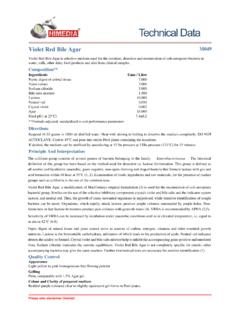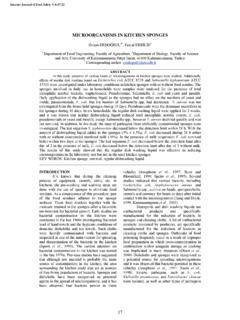Transcription of Microbiological Media for Bacteria and Wild Yeast ...
1 Microbiological Media for Bacteria and Wild Yeast detection in the Brewery. Gary Spedding, BDAS, LLC (From a 2000 Seminar). Abstract. The brewery microbiologist, expert and novice alike, has been presented with a very wide array of growth Media within the past 50 years. The choice of which Media to choose for a particular purpose ( Yeast , wild Yeast , mould or bacterial strain selection, detection and identification) has not always been an easy one. This paper will provide a listing of the properties of a select few Media useful for the brewing microbiologist. The topic will be handled from the perspective of the novice microbiologist in the craft brewery environment. In consequence of this, the considerations for the selection and use of such Media will be discussed. Furthermore, as a prelude to the main topic, a discussion as to the types of, and the properties of, various microbial contaminants most commonly found in the brewery will be entertained.
2 Introduction. The ideal situation for the lager and ale brewer is to have only one species of organism ever present in the beer; namely the culture Yeast pitched into the hopped wort. However, by the very nature of the sheer abundance of microorganisms present in the environment this ideal situation is never realized. There are many bacterial species and wild yeasts (also moulds) in the environment or in the brewers raw materials, which can infect beer; some cause damage while others do not. Every brewer must therefore be aware of the types of organisms, the kinds of spoilage they can render on the final product, and how to effectively remove them as potential contaminants. The detection of contaminating Bacteria and wild Yeast strains is often very much easier than their identification; wild Yeast strains being much more difficult to identify than individual bacterial strains.
3 The purpose, therefore, of this paper is not to describe in any detail how to detect and recognize many individual species. Instead, the intention is to illustrate a few of the most useful kinds of Media available which will enable you as a microbiologist to determine if you do actually have contamination by wild Yeast or beer spoiling Bacteria . The mere presence of contaminants 1 is sufficient news to send most brewers back into the brewery in order to locate and clean up the source of contamination. Some History and Recent Developments. In 1950 two microbiologists, Green and Grey, introduced the antibiotic cycloheximide (actidione) as a very powerful inhibitor of culture Yeast . Through the use of cycloheximide the main organism found in fermenting wort and beer (the culture Yeast !) could be suppressed. This suppression allowed most other contaminating organisms to grow and to be visualized on/in the culture Media .
4 Cycloheximide was thus introduced into many selective Media from the 1950s through the 1980s. In addition, many other types of growth Media were also developed during this period. Nine Media are described in this paper (some incorporating cycloheximide into the formula and some not) which can be used to determine bacterial and wild Yeast contamination. One major problem has now, however, arisen for the microbiologist in that the antibiotic cycloheximide is no longer available. Brewers will need to be aware of this as they now select the kinds of Media that they will use in their own breweries. More importantly microbiologists now need to go and find other antibiotics and inhibitors of culture Yeast which will prove as useful as cycloheximide. Beer Spoilage. The potential sources of beer spoilage organisms in the brewery include air, soil, water, raw materials, grain/malt dust, pitching Yeast , processing aids, vermin, human skin, brewery equipment, plant and machinery.
5 The types of spoilage caused by microorganisms include the following; turbidity, haze formation, rope (slime) formation, over-attenuation, gushing, souring of wort and beer and the production of varied off-flavors. Some of the key organisms ( Yeast and Bacteria ) that are responsible for beer spoilage are illustrated in Table 1. As a brewer, a comprehensive knowledge of the types of organisms that can result in beer spoilage is most important. An understanding of the sources of infection, together with a knowledge of the kinds of damage (including the aromas and flavors) caused by microorganisms, can provide a useful baseline which can be used to guide the type of microbiology testing needed when a contamination issue arises. Presented in Table 1 is a listing of Bacteria and wild Yeast strains, along with key characteristics 2 of morphology, behavior, and kinds of damage caused by them.
6 Following this, the article moves on into looking at several key Media that can be used in the detection , identification and enumeration of wort and beer spoiling organisms. The brewer can often gauge the type of damage caused in the infected beer by simple visual inspection of the product and by tasting. This preliminary testing is then followed by implementation of Microbiological procedures in order to identify the contaminating organism(s). The location of the contamination in the brewery is also determined via microbiology testing. For the expert, the colony morphologies, sizes, and colors of the organisms growing on selected Media can be used to more specifically identify bacterial and Yeast strains. Table 1. Some of the main beer spoilage organisms and their properties. Organism Properties Bacteria Lactobacillus Produce silky turbidity and makes beer sour via lactic (and acetic) acid production.
7 Some strains produce diacetyl; some produce rope. Gram positive, rod shaped cells. Catalase negative. Facultative anaerobes. Hop tolerant. Pediococcus Makes beer sour (Lactic acid). Some strains produce diacetyl. Gram positive, round (coccus-shaped) cells frequently found as tetrads but can appear as diplococci. Only cocci to grow in beer. Beer sarcina organisms. Catalase negative. Enterobacteriaceae A family that includes the coliform Bacteria . Often found in water supplies. Gram negative with rod-shaped cells. Most are facultative anaerobes. Grow in wort to produce off-flavors (acetate, celery-like, parsnip, phenols, cooked 3 cabbage and DMS) but do not usually grow in beer. All catalase positive and oxidase negative. Includes the genera, Escherichia, Aerobacter and Klebsiella. Acetobacter Gram negative. These organisms are very small and exhibit varied rod-shaped cells.
8 Produce acetic acid (vinegar) in beer and ropiness. An overoxidizer. Aerobes. Catalase positive and oxidase negative. Hop resistant Gluconobacter Formerly called Acetomonas. Gram negative. These appear as very small rod-shaped cells. Produce acetic acid in beer, sometimes giving a cidery note. Aerobes. Catalase positive and oxidase negative. Zymomonas Gram negative plump rod-shaped cells that can grow in cask-conditioned beer. They are quite common in water, soil and plant material. May form clumps or rosettes. Prefer acidic to neutral pH. Anaerobic. Produce off-flavors (acetaldehyde; rotten apples! and hydrogen sulfide) and turbidity. Pectinatus Gram negative, rod-shaped and strictly anaerobic. Produce a range of off-flavors (acids and organic sulfur compounds) and turbidity. Yeast Saccharomyces Wild strains produce phenolic off-flavors and can lead to over-carbonation of beer via over-attenuation.
9 Brettanomyces Produce large quantities of acids and are a major contributor of other off-flavors (ethyl acetate and ethyl lactate), especially in draft beers. Aerobic. Very slow growing (detect problem after 1- 2 months!) 4 Dekkera This Yeast produces acetic acid. Kloeckera Produce acids and other off-flavors (acetic acid, lactic acid, esters). Aerobic. Causes cloudiness in beer. Pichia* Produces cloudiness and off-flavors. Aerobic. Candida* Produces cloudiness and off-flavors (esters, acids, phenolics). Aerobic. Hansenula* Produces cloudiness and off-flavors. *As these organisms are aerobes, their spoilage potential is limited to beers stored in the presence of air. However, under suitable conditions they grow rapidly and often give rise to films on the surface of the beer as well as resulting in the production of hazes and off-flavors. A Discussion of Brewery Bacteria .
10 The identification of beer spoilage Bacteria is of primary importance to the brewer. Bacterial contamination s in the brewery of concern to the brewer fall into two categories, beer spoilers and wort spoilers. The most common and most troublesome of the beer spoilers are the lactic acid Bacteria (see Table 1). These organisms thrive during oxygen deprivation in fermentation and storage. About 10000 lactic acid Bacteria per mL produce detectable spoilage of beer. Wort spoilers, on the other hand, grow and spoil beer in the early stages of fermentation. These typically belong to the family Enterobacteriaceae (Table 1). Depending on the specific organism in the Enterobacteriaceae family only 300-800 Bacteria per mL can lead to the spoilage of beer. In addition to these organisms there are indeed many others that can grow in the rich substrate of beer, many being classified as non-beer spoilage Bacteria .





